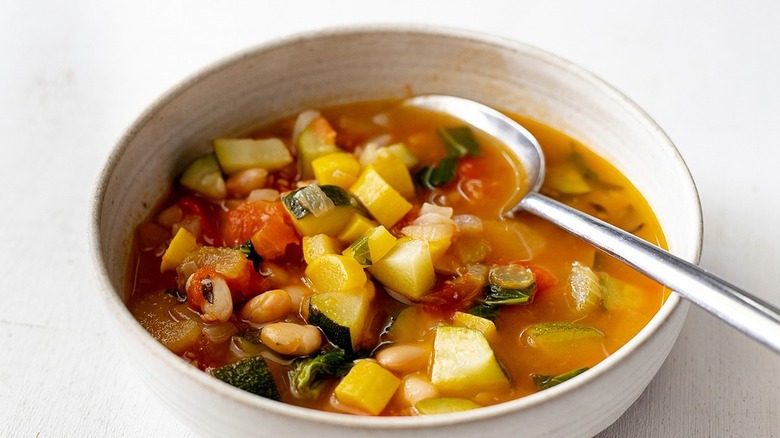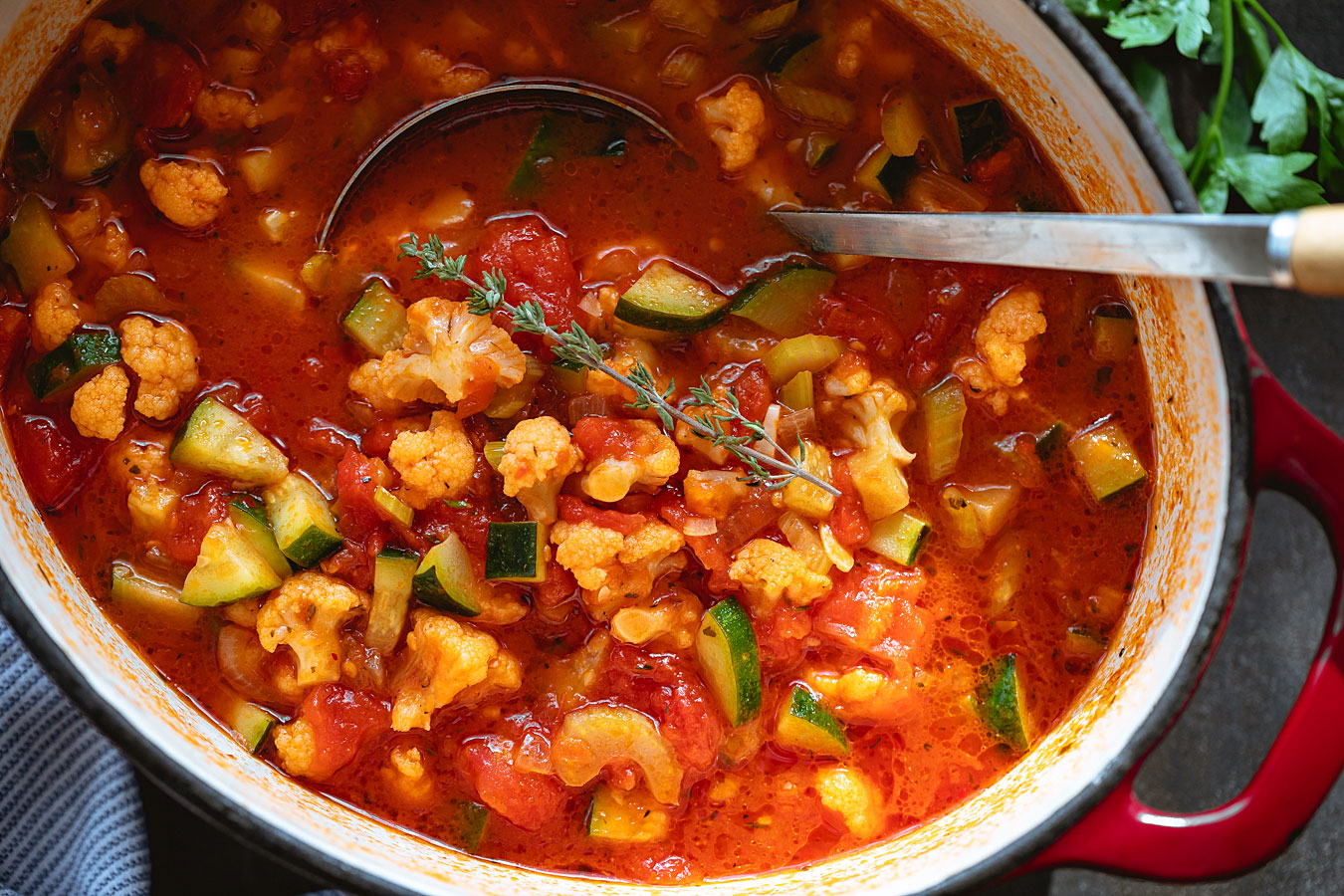Embark on a culinary journey where health and flavor intertwine seamlessly. Our comprehensive guide to crafting the perfect healthy vegetable soup will empower you to create a nourishing and delectable dish that will tantalize your taste buds and invigorate your well-being.
From the selection of nutrient-rich vegetables to the art of broth-making and flavor enhancement, we will delve into every aspect of this culinary masterpiece. Discover the secrets to transforming simple ingredients into a symphony of flavors that will warm your soul and nourish your body.
Healthy Vegetable Soup Ingredients

A healthy vegetable soup is a great way to get your daily dose of vegetables. It’s also a delicious and satisfying meal that can be enjoyed by people of all ages. Here is a list of essential and optional vegetables for a healthy vegetable soup, along with their nutritional benefits:
Essential Vegetables
- Carrots: Carrots are a good source of vitamin A, which is important for vision, immune function, and skin health. They also contain beta-carotene, an antioxidant that has been linked to a reduced risk of heart disease and cancer.
- Celery: Celery is a good source of vitamins A, C, and K, as well as fiber. It also contains antioxidants that have been shown to reduce inflammation and protect against heart disease.
- Onions: Onions are a good source of vitamins C and B6, as well as fiber. They also contain antioxidants that have been shown to reduce cholesterol levels and protect against heart disease.
- Potatoes: Potatoes are a good source of vitamins C and B6, as well as fiber. They also contain potassium, which is important for blood pressure control.
- Tomatoes: Tomatoes are a good source of vitamins A, C, and K, as well as lycopene, an antioxidant that has been linked to a reduced risk of heart disease and cancer.
Optional Vegetables
- Asparagus: Asparagus is a good source of vitamins A, C, and K, as well as fiber. It also contains antioxidants that have been shown to reduce inflammation and protect against heart disease.
- Broccoli: Broccoli is a good source of vitamins A, C, and K, as well as fiber. It also contains sulforaphane, a compound that has been shown to have anti-cancer properties.
- Brussels sprouts: Brussels sprouts are a good source of vitamins A, C, and K, as well as fiber. They also contain antioxidants that have been shown to reduce inflammation and protect against heart disease.
- Green beans: Green beans are a good source of vitamins A, C, and K, as well as fiber. They also contain chlorophyll, a compound that has been shown to have antioxidant and anti-inflammatory properties.
- Mushrooms: Mushrooms are a good source of vitamins B and D, as well as fiber. They also contain antioxidants that have been shown to reduce inflammation and protect against heart disease.
- Spinach: Spinach is a good source of vitamins A, C, and K, as well as fiber. It also contains lutein, an antioxidant that has been shown to protect against eye diseases.
When choosing vegetables for your healthy vegetable soup, be sure to select a variety of colors and textures. This will ensure that you get a wide range of nutrients and antioxidants. You can also add beans, lentils, or rice to your soup for additional protein and fiber.
Vegetable Preparation and Cutting Techniques
Proper preparation of vegetables is essential for achieving optimal flavor and texture in vegetable soups. Different vegetables require specific cutting techniques that affect the cooking time and final texture of the soup.
Cutting Techniques
- Chopping: Cutting vegetables into small, uniform pieces ensures even cooking and a tender texture.
- Dicing: Cutting vegetables into small, square pieces creates a firm texture and is often used for root vegetables like carrots and celery.
- Mincing: Finely chopping vegetables, such as onions and garlic, releases their aromatic oils and intensifies their flavor.
- Slicing: Cutting vegetables into thin, even slices, such as for bell peppers or zucchini, allows for quick cooking and a delicate texture.
- Julienning: Cutting vegetables into thin, matchstick-like pieces, such as carrots or cucumbers, creates a decorative and texturally interesting addition to soups.
By choosing the appropriate cutting technique for each vegetable, you can enhance the flavor, texture, and overall quality of your vegetable soup.
Broth Options and Flavor Enhancements

Vegetable soup is a versatile dish that can be customized to suit your taste preferences. One of the key elements that determines the flavor of the soup is the broth you use. There are many different types of broth available, each with its own unique flavor profile and nutritional value.
Types of Broth
- Chicken broth is a classic choice for vegetable soup. It has a mild, savory flavor that pairs well with a variety of vegetables. Chicken broth is also a good source of protein and vitamins.
- Beef broth is a more robust option that adds a richer flavor to vegetable soup. It is made from beef bones and meat, and is a good source of protein, iron, and zinc.
- Vegetable broth is a lighter option that is made from vegetables, herbs, and spices. It is a good choice for vegetarians and vegans, and is also a good source of vitamins and minerals.
Making Homemade Vegetable Broth
Homemade vegetable broth is a great way to add flavor and nutrients to your vegetable soup. To make homemade vegetable broth, simply simmer vegetables, herbs, and spices in water for several hours. You can use any vegetables you like, but some good options include carrots, celery, onions, garlic, and tomatoes.
Making homemade vegetable broth is a great way to use up leftover vegetables. It is also a good way to save money, as it is much cheaper than store-bought broth.
Flavor Enhancements
In addition to choosing the right broth, there are a number of other ways to enhance the flavor of your vegetable soup. Here are a few tips:
- Add herbs and spices. Herbs and spices can add a lot of flavor to vegetable soup. Some good options include thyme, rosemary, oregano, basil, bay leaves, and black pepper.
- Use fresh ingredients. Fresh ingredients will always give your soup the best flavor. If possible, use fresh vegetables, herbs, and spices.
- Sauté your vegetables. Sautéing your vegetables before adding them to the soup will help to develop their flavor.
- Simmer your soup for several hours. The longer you simmer your soup, the more flavorful it will become.
Cooking Methods and Techniques
Vegetable soup offers a myriad of cooking methods to achieve distinct flavors and textures. Understanding the advantages and limitations of each technique empowers you to tailor the soup to your preferences.
Boiling
Boiling is a straightforward method that involves submerging vegetables in boiling water. This rapid cooking process preserves the vibrant colors and nutrients of vegetables like carrots, celery, and green beans.
Simmering
Simmering involves cooking vegetables in gently boiling water below the boiling point. This extended cooking time allows flavors to meld and develop, resulting in a rich and flavorful soup. Vegetables suitable for simmering include onions, leeks, and root vegetables like potatoes.
Slow Cooking
Slow cooking, often done in a crockpot or Dutch oven, involves cooking vegetables over a low heat for an extended period. This method tenderizes tough vegetables like beef and root vegetables, while infusing the soup with deep, complex flavors.
Creating a Flavorful Soup Base
To create a flavorful soup base, sauté aromatic vegetables like onions, garlic, and celery in a pot before adding liquids. This process enhances the flavors and adds depth to the soup. Incorporate herbs and spices during cooking to further enhance the taste.
Incorporating Vegetables
Add vegetables in order of their cooking time. Harder vegetables like root vegetables and cruciferous vegetables should be added first, followed by softer vegetables like tomatoes and leafy greens. This ensures even cooking and prevents overcooking.
Serving Suggestions and Garnish Options
To enhance the enjoyment of your wholesome vegetable soup, consider serving it alongside an assortment of accompaniments that complement its flavors and textures. Crusty bread, with its crispy exterior and soft interior, is a classic pairing that allows you to soak up every delicious spoonful.
Crackers, with their crunchy texture and variety of flavors, offer another delightful option. A fresh side salad, with its vibrant colors and crisp greens, adds a refreshing contrast to the warm and comforting soup.
Garnish Enhancements
Garnishing your vegetable soup is an essential step not only for visual appeal but also for adding extra layers of flavor and aroma. Fresh herbs, such as chopped parsley, cilantro, or chives, provide a vibrant pop of color and a herbaceous freshness.
Diced vegetables, such as bell peppers, carrots, or green onions, add a touch of crunch and a burst of color. Toasted nuts, such as almonds or walnuts, offer a nutty richness and a satisfying textural contrast.
Closing Summary
As you embark on your vegetable soup-making adventures, remember that customization is key. Experiment with different ingredients, flavors, and cooking techniques to create a dish that perfectly aligns with your palate and dietary needs. Whether you prefer a classic, hearty soup or a lighter, more vibrant variation, the possibilities are endless.
With each spoonful, savor the symphony of flavors and nutrients that this healthy vegetable soup offers. May it become a staple in your culinary repertoire, bringing joy, nourishment, and well-being to your life.
FAQ Corner
Can I use frozen vegetables in my soup?
Yes, frozen vegetables are a convenient option and retain most of their nutrients. Simply add them to the soup frozen, adjusting the cooking time as needed.
How do I store leftover vegetable soup?
Store leftover soup in an airtight container in the refrigerator for up to 3 days, or in the freezer for up to 3 months. Thaw frozen soup overnight in the refrigerator before reheating.
Can I add other ingredients to my soup, such as meat or beans?
Absolutely! Feel free to customize your soup by adding cooked meat, beans, lentils, or pasta. These additions will enhance the nutritional value and texture of your soup.
